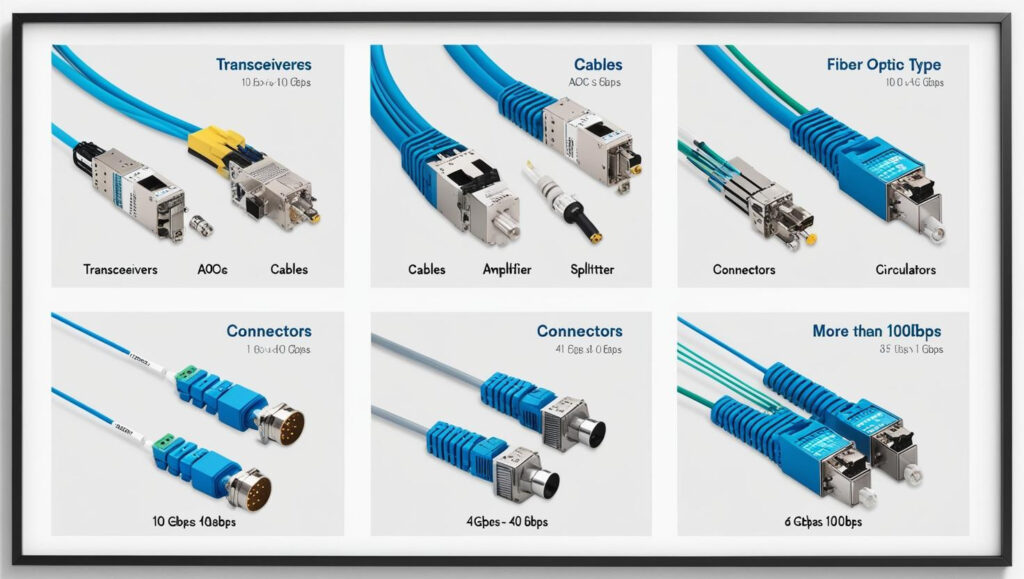The fiber optic components market has witnessed substantial growth in recent years, driven by increasing demand for high-speed internet, data centers, cloud computing, and 5G networks. Fiber optic technology has become a backbone for modern telecommunication and networking systems, enabling ultra-fast data transmission, low latency, and high bandwidth capabilities.
This article provides an in-depth analysis of the global fiber optic components market, covering market size, key growth drivers, challenges, and leading players shaping the industry.
Download PDF Brochure @ https://www.marketsandmarkets.com/pdfdownloadNew.asp?id=63775446

Global Fiber Optic Components Market Overview
Fiber optic components are essential building blocks in fiber optic networks, facilitating signal transmission, amplification, and connectivity. These components include:
- Fiber optic cables
- Optical transceivers
- Optical amplifiers
- Fiber optic splitters and connectors
- Wavelength division multiplexers (WDMs)
The increasing demand for high-speed data transfer, improved connectivity, and advanced communication networks has positioned fiber optic technology as a key enabler of digital transformation.
Market Size and Share Analysis
The fiber optic components market is expected to grow from USD 36.69 billion in 2025 to USD 58.65 billion by 2030, growing at a CAGR of 9.8% from 2025 to 2030.
Regional Market Analysis
- North America holds a significant share due to strong investments in 5G infrastructure, data centers, and broadband expansion. The U.S. leads in fiber optic deployments, driven by major telecom operators like AT&T, Verizon, and T-Mobile.
- Asia-Pacific is the fastest-growing market, with China, Japan, and India investing heavily in fiber-optic-based telecom infrastructure. The rapid expansion of smart cities, IoT, and cloud services is fueling demand.
- Europe is witnessing steady growth, supported by the EU’s Gigabit Society initiative aiming to expand fiber broadband across households and businesses.
- Latin America and the Middle East & Africa are emerging markets, where governments and private entities are investing in fiber-optic-based connectivity solutions.
Growth Drivers in the Fiber Optic Components Market
1. 5G Network Deployment and High-Speed Broadband Demand
- The rapid rollout of 5G networks is driving demand for fiber optic components in telecom infrastructure.
- Fiber optic backhaul solutions enable seamless high-speed data transmission for 5G base stations.
- Governments and telecom companies are replacing copper-based networks with fiber optic broadband, boosting component demand.
2. Growth of Data Centers and Cloud Computing
- The increasing adoption of cloud computing, edge computing, and hyperscale data centers is fueling demand for fiber optic connectivity.
- Data center operators, including Amazon Web Services (AWS), Microsoft Azure, and Google Cloud, are deploying high-speed fiber optic networks to improve data transmission efficiency.
3. Rising Adoption of IoT and Smart Cities
- IoT applications in smart cities, industrial automation, healthcare, and autonomous vehicles require high-bandwidth fiber optic networks.
- Governments worldwide are investing in fiber-optic-based smart infrastructure, accelerating market growth.
4. Increasing Demand for High-Quality Video Streaming and Online Gaming
- The rise of video streaming services, 4K/8K content, and online gaming is boosting demand for fiber-optic-enabled broadband networks.
- Platforms like Netflix, YouTube, and Twitch require low-latency, high-bandwidth connectivity, driving fiber optic expansion.
5. Expansion of Fiber-to-the-Home (FTTH) and Fiber-to-the-Building (FTTB) Networks
- Telecom providers are deploying FTTH and FTTB solutions to offer ultra-fast internet speeds for residential and commercial users.
- Countries like China, India, the U.S., and Germany are leading fiber broadband penetration rates.
Challenges and Restraints in the Fiber Optic Components Market
1. High Initial Investment and Deployment Costs
- The installation of fiber optic infrastructure requires substantial capital investment, making it cost-intensive for network operators.
- The cost of fiber optic cables, connectors, and transceivers is higher than traditional copper-based networks.
2. Supply Chain Disruptions and Raw Material Shortages
- The global supply chain for fiber optic components has been affected by semiconductor shortages, trade restrictions, and rising raw material costs.
- Delays in component manufacturing and logistics have impacted the fiber optic network expansion rate.
3. Skilled Workforce Shortage for Fiber Optic Deployment
- The industry faces a shortage of trained professionals for fiber optic installation, maintenance, and troubleshooting.
- Companies are investing in workforce training programs to address this issue.
4. Competition from Wireless and Satellite-Based Internet Solutions
- Wireless communication technologies like Starlink’s satellite internet and 6G research may pose competition to fiber-optic-based broadband.
- However, fiber optics remains superior in speed, reliability, and bandwidth capacity.
Key Players in the Fiber Optic Components Industry
The fiber optic components market is highly competitive, with key players investing in R&D and strategic partnerships to gain a market edge.
Leading Companies in the Industry
- Corning Inc. – A leading manufacturer of fiber optic cables and optical networking solutions.
- Finisar Corporation (II-VI Incorporated) – Specializes in optical transceivers and WDM solutions.
- Fujikura Ltd. – Develops fiber optic cables, fusion splicers, and optical connectors.
- Sumitomo Electric Industries, Ltd. – Offers a wide range of fiber optic communication solutions.
- Lumentum Holdings Inc. – Focuses on optical networking and fiber optic transceiver technologies.
The global fiber optic components market is poised for strong growth, driven by the increasing demand for high-speed connectivity, 5G deployment, data centers, and cloud computing. While challenges such as high deployment costs and supply chain disruptions persist, ongoing technological advancements and government investments in fiber-optic-based infrastructure are creating significant growth opportunities.